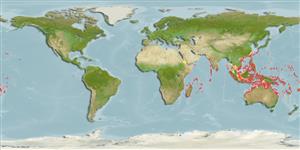Actinopterygii (ray-finned fishes) >
Perciformes (Perch-likes) >
Acanthuridae (Surgeonfishes, tangs, unicornfishes) > Acanthurinae
Etymology: Paracanthurus: Greek, para = the side of + Greek, akantha = thorn + Greek, oura = tail (Ref. 45335).
Environment / Climate / Range
Ecology
Marine; reef-associated; depth range 2 - 40 m (Ref. 1602), usually 10 - 40 m (Ref. 27115). Tropical; 24°C - 26°C (Ref. 27115), preferred ?; 30°N - 30°S, 32°E - 170°W
Indo-Pacific: East Africa, including the Mascarene Islands (Ref. 37792) to Kiribati, north to southern Japan, south to the southern Great Barrier Reef, New Caledonia, and Samoa.
Size / Weight / Age
Maturity: Lm ? range ? - ? cm
Max length : 31.0 cm TL male/unsexed; (Ref. 2334)
Occur in clear, current-swept terraces of seaward reefs. Observed in loose aggregations 1 or 2 meters above the bottom; juveniles and subadults typical in groups near isolated Pocillopora eydouxi coral heads and when alarmed hide themselves tightly among the branches (Ref. 9710). Benthopelagic (Ref. 58302). Feed on zooplankton and occasionally on algae (Ref. 9710, 48637, 27115, 83665). Relatively uncommon and highly localized (Ref. 1602, 9710). Very popular and hardy aquarium fish. Anterolateral glandular groove with venom gland (Ref. 57406).
Life cycle and mating behavior
Maturity | Reproduction | Spawning | Eggs | Fecundity | Larvae
Myers, R.F., 1991. Micronesian reef fishes. Second Ed. Coral Graphics, Barrigada, Guam. 298 p. (Ref. 1602)
IUCN Red List Status (Ref. 115185)
CITES (Ref. 94142)
Not Evaluated
Human uses
Aquarium: commercial
More information
Common namesSynonymsMetabolismPredatorsEcotoxicologyReproductionMaturitySpawningFecundityEggsEgg development
ReferencesAquacultureAquaculture profileStrainsGeneticsAllele frequenciesHeritabilityDiseasesProcessingMass conversion
Tools
Special reports
Download XML
Internet sources
Estimates of some properties based on models
Phylogenetic diversity index (Ref.
82805): PD
50 = 1.0000 [Uniqueness, from 0.5 = low to 2.0 = high].
Bayesian length-weight: a=0.02291 (0.01093 - 0.04802), b=2.97 (2.79 - 3.15), in cm Total Length, based on LWR estimates for this (Sub)family-body shape (Ref.
93245).
Trophic Level (Ref.
69278): 3.4 ±0.45 se; Based on food items.
Resilience (Ref.
69278): High, minimum population doubling time less than 15 months (Preliminary K or Fecundity.).
Vulnerability (Ref.
59153): Low to moderate vulnerability (28 of 100) .
